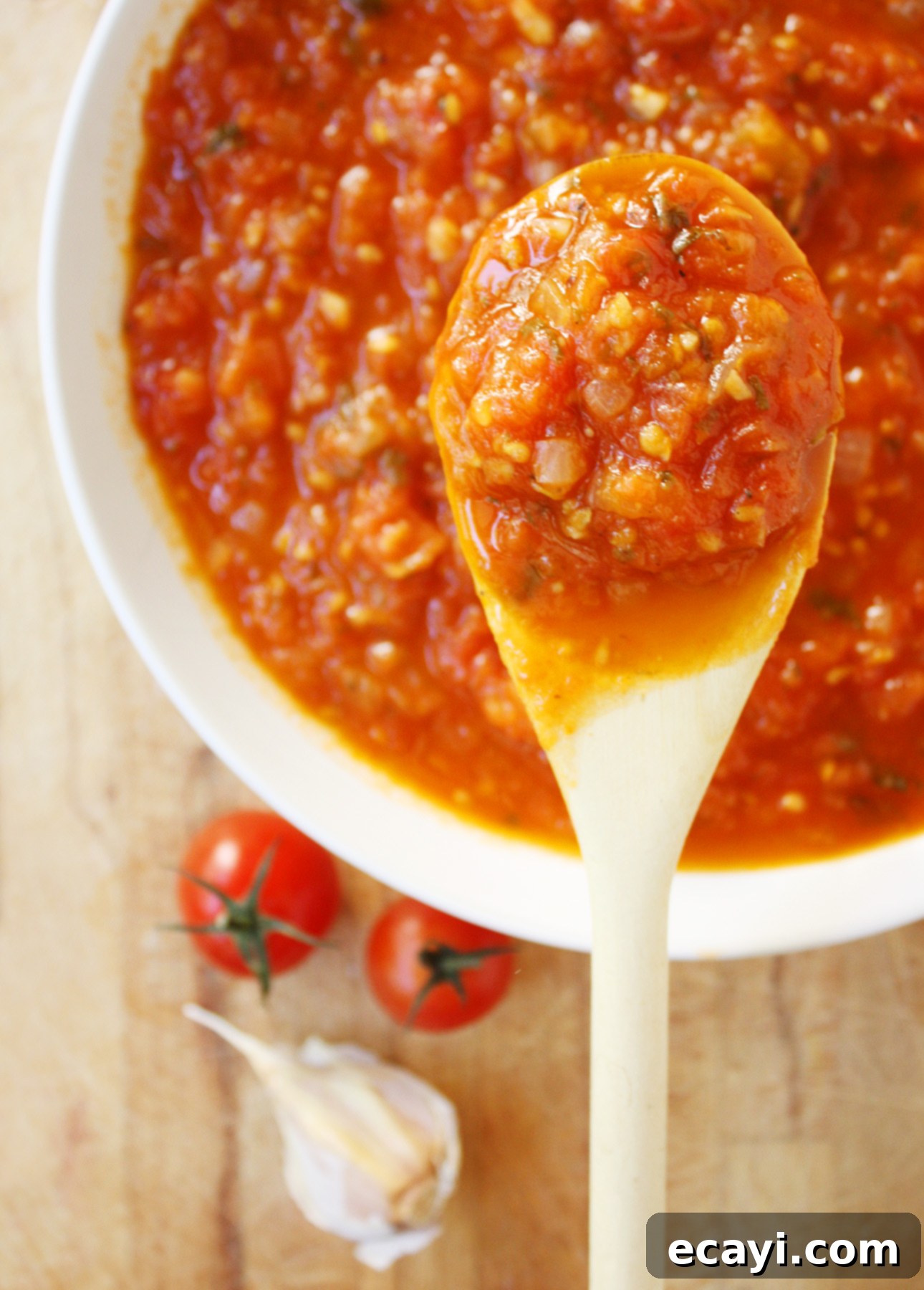Homemade Fresh Tomato Sauce: Capturing Summer’s Peak Flavor
Experience the unparalleled taste of peak-season produce with this incredible Fresh Tomato Sauce recipe. Learn how to transform nature’s summer bounty into a simple, aromatic, and deeply flavorful sauce that can elevate countless dishes. This guide covers everything from selecting the best tomatoes and easy peeling techniques to perfecting the simmer and versatile serving suggestions.
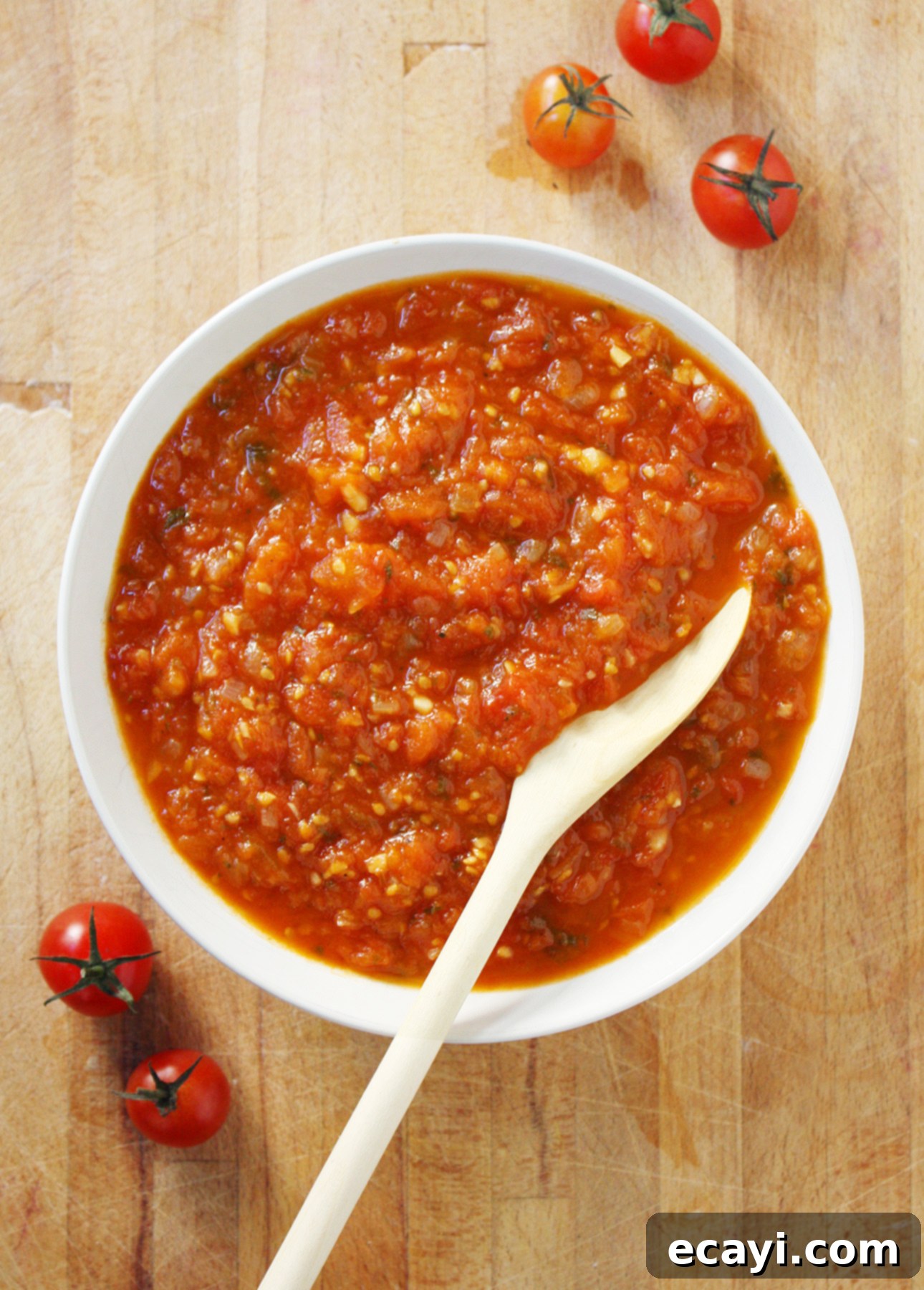
This post contains affiliate links. Full disclosure is at the bottom of the article.
The Irresistible Allure of Homemade Fresh Tomato Sauce
As summer ripens, our gardens and local farmer’s markets overflow with an abundance of juicy, sun-kissed tomatoes. It’s a sight that inspires many culinary adventures, but also poses a delightful challenge: what do you do with 5 pounds of perfectly ripe tomatoes? While a classic BLT is always a treat, it’s hardly the most efficient way to savor and preserve the incredible flavor of seasonal tomatoes. With a vacation looming and a mountain of vibrant red goodness, my thoughts invariably turn to the heart of Italian cuisine: a rich, aromatic, and homemade fresh tomato sauce.
Many home cooks, and even professional chefs, often reach for canned tomatoes, especially the renowned San Marzano variety. They are praised for their consistency and the fact that they are picked at their peak ripeness and processed within hours, offering a reliable taste of summer all year round. And indeed, they are excellent. However, when fresh, in-season tomatoes are readily available, opting for their canned counterparts feels like a missed opportunity – a culinary “sin,” as even many Italians would agree. While the idea of peeling, chopping, and simmering fresh tomatoes might seem daunting, the process is far simpler than you might imagine. And the reward? A vivacious, incomparable taste that only a truly fresh tomato sauce can deliver, bursting with the authentic flavors of summer.
Why Choose Fresh Over Canned Tomatoes?
The distinction between fresh and canned tomatoes goes beyond mere convenience. When you use fresh, ripe, in-season tomatoes, you’re harnessing a flavor profile that is simply unavailable in any jar or can. Fresh tomatoes boast a bright acidity perfectly balanced with natural sweetness, a delicate aroma, and a nuanced texture that canned versions, however high quality, cannot fully replicate. They contain more natural enzymes and live compounds that contribute to a “fresher” taste. Furthermore, using tomatoes from your garden or a local farmer’s market often means they haven’t traveled far, reducing their environmental footprint and supporting local agriculture. This direct connection to the source enhances the overall experience of cooking and eating, allowing you to create a truly authentic tomato sauce.
Selecting the Perfect Tomatoes for Your Sauce
The foundation of an exceptional homemade fresh tomato sauce lies in choosing the right tomatoes. Look for tomatoes that are heavy for their size, uniformly colored, and free of blemishes. They should yield slightly to gentle pressure and emit a sweet, earthy aroma, particularly around the stem end. While any ripe tomato can be used, certain varieties are particularly suited for sauce-making:
- Roma Tomatoes (Plum Tomatoes): These are a classic choice due to their firm, meaty flesh, low water content, and fewer seeds. Their elongated shape makes them easy to handle, and they break down beautifully into a thick, smooth sauce without requiring extensive simmering to reduce excess liquid. Roma tomatoes are widely available and consistently perform well for homemade sauces.
- San Marzano Tomatoes: Often considered the gold standard, authentic San Marzano tomatoes (from the Agro Sarnese-Nocerino region of Italy) are a plum variety known for their balanced sweet flavor, low acidity, and thick walls. If you can find fresh San Marzanos, they are truly unparalleled for creating an authentic Italian tomato sauce.
- Other Paste Varieties: Many other plum-shaped or “paste” tomatoes, like Amish Paste or Speckled Roman, offer similar characteristics to Romas and San Marzanos, making them excellent choices for a hearty, flavorful sauce.
- Heirloom and Garden Varieties: Don’t hesitate to use flavorful heirloom tomatoes or mixed garden varieties. While they might be juicier and require a longer simmer, their complex and unique flavors can add incredible depth and character to your homemade fresh tomato sauce, making each batch truly special.
Humble (but very tasty!) garden tomatoes, the perfect starting point for an authentic homemade sauce. Their natural sweetness and vibrant color are ideal for a fresh tomato sauce recipe.
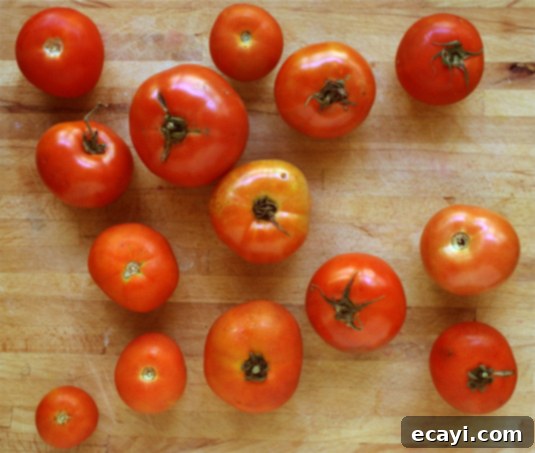
The Simple Art of Peeling Fresh Tomatoes
One of the most common reasons people shy away from making fresh tomato sauce is the perceived difficulty of peeling tomatoes. However, it’s surprisingly simple and quick, making your homemade sauce smoother and more refined. Removing the skins ensures a consistently velvety texture, free from any tough or chewy bits. Here’s how to do it efficiently with the blanching method:
- Prepare the Water and Ice Bath: Bring a large pot of water to a vigorous, rolling boil. While the water heats, prepare an ice bath by filling a large bowl with ice and water. This will be crucial for stopping the cooking process quickly.
- Score the Tomatoes: Using a sharp paring knife, make a shallow “X” incision on the bottom of each tomato. This score should just break through the skin, not cut deep into the flesh. The “X” acts as a starting point for the skin to easily peel away.
- Blanch in Boiling Water: Carefully plunge a few tomatoes into the boiling water. Avoid overcrowding the pot; work in batches if necessary to maintain water temperature. Let them cook for just 10 to 15 seconds, or until you visibly see the skin around the “X” begin to pucker, curl back, or loosen significantly. This short burst of heat is enough to separate the skin from the flesh.
- Shock in Ice Bath: Immediately transfer the blanched tomatoes from the boiling water to the ice bath using a slotted spoon. This “shocks” the tomatoes, stopping the cooking process and making the skins incredibly easy to remove. Let them sit in the ice bath for a minute or two until cool enough to handle.
- Effortless Peeling: Once the tomatoes are cool, retrieve them from the ice bath. You’ll find their skins slip off effortlessly, often in large pieces, starting from the scored “X” mark. Discard the skins.
This quick blanching method ensures your fresh tomato sauce will have a silky, smooth consistency without any tough bits of skin, enhancing the overall dining experience.
Slice a shallow “X” on the bottom of each tomato, a crucial step for easy peeling and creating a smooth, fresh tomato sauce.
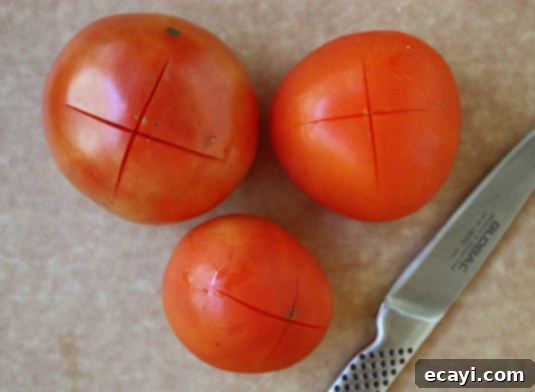
Tomatoes, after 10-15 seconds in boiling water: ready to undress! The skin begins to visibly peel back, signaling they are perfectly blanched for easy removal.
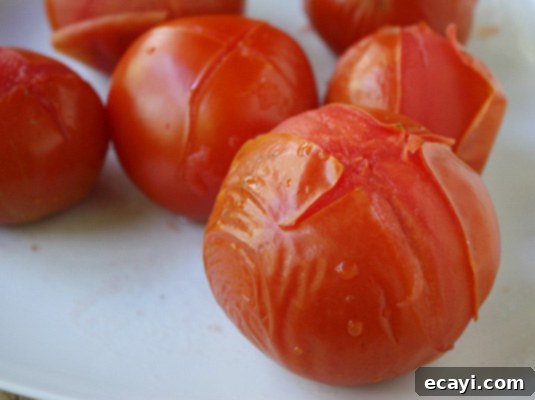
5 pounds of fresh and peeled garden tomatoes, prepared and ready to be chopped for a delicious homemade fresh tomato sauce. Their smooth texture is perfect for simmering.
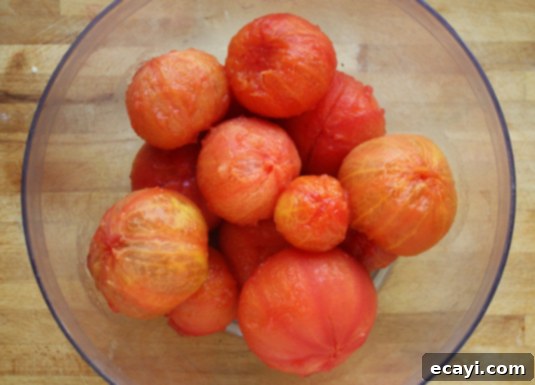
Peeled tomatoes, coarsely chopped, ready for the pot. Keeping the seeds and juice adds essential flavor and body, creating a rich base for your fresh tomato sauce.
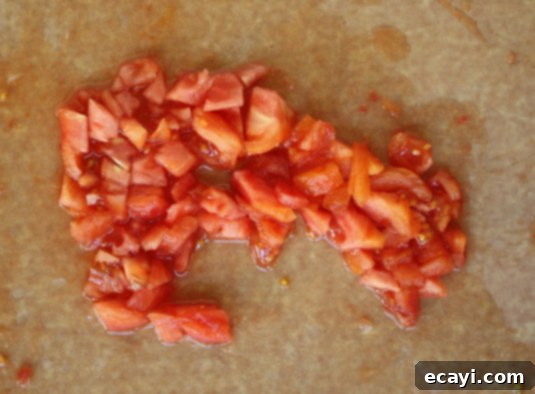
Crafting the Perfect Flavor Profile for Your Fresh Tomato Sauce
While a basic fresh tomato sauce can be exquisitely simple, seasoned only with salt and pepper to let the tomatoes truly shine, building layers of flavor can transform it into something truly extraordinary. My preferred method, inspired by culinary experts like Deborah Madison, embraces a variety of aromatic ingredients that deepen the sauce’s character without overpowering the fresh tomato taste. This approach ensures a complex and well-rounded flavor that is unmistakably homemade.
Here’s how to build a robust and aromatic base for your fresh tomato sauce:
- Onion and Garlic: These are the foundational aromatics of almost any great sauce. Sautéing finely minced yellow onion until translucent (not browned!) creates a sweet, savory base. Adding minced garlic and a pinch of crushed red pepper flakes shortly after infuses the olive oil with warmth and a subtle kick. The key is to cook them gently to release their essence without burning, which can turn them bitter and compromise the delicate flavor of your fresh tomato sauce.
- Crushed Red Pepper Flakes: Even if you don’t typically prefer spicy food, a tiny amount of red pepper flakes adds a beautiful warmth and complexity. It helps to balance the sweetness and acidity of the tomatoes, providing a nuanced depth rather than overpowering heat.
- Dry White Wine: This is a personal touch that I’ve found significantly enhances the sauce’s complexity. After sautéing the aromatics, deglazing the pan with a dry white wine (like Pinot Grigio or Sauvignon Blanc) allows you to scrape up any flavorful bits stuck to the bottom, intensifying the overall depth. The alcohol evaporates during cooking, leaving behind a subtle fruity and acidic note that beautifully complements the tomatoes and helps to mellow their fresh, sometimes sharp, acidity.
- Dried Oregano: This classic Italian herb pairs perfectly with tomatoes. Dried oregano releases its flavors slowly as the sauce simmers, adding an earthy, slightly peppery note that is essential for an authentic Italian fresh tomato sauce.
- Salt and Freshly Ground Black Pepper: Essential for proper seasoning. Start with a conservative amount of kosher or fine sea salt and black pepper at the beginning of cooking, and adjust towards the end, as the sauce reduces and flavors concentrate. This ensures your fresh tomato sauce is perfectly balanced.
- Fresh Basil: This delicate herb is the crowning glory of fresh tomato sauce. However, its flavor is easily lost with prolonged cooking or freezing. For the best taste, fresh basil should always be stirred in right before serving, after the sauce has come off the heat. This allows its bright, sweet, and peppery notes to delicately infuse the sauce, providing a burst of freshness that ties all the flavors together. If you plan to freeze your sauce, omit the fresh basil and add it after thawing and reheating for optimal results.
Optional fresh tomato sauce seasonings: onion, garlic, dried oregano, red pepper flakes, fresh basil – the building blocks of an incredibly flavorful and aromatic homemade sauce.
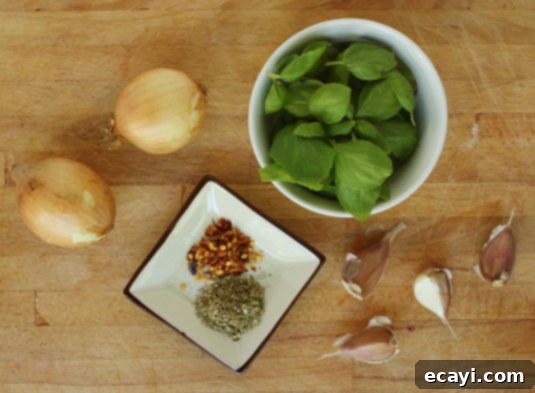
The Art of Simmering: Achieving Perfect Consistency for Your Fresh Tomato Sauce
Once your peeled and chopped tomatoes join the flavorful base, the magic of simmering begins. This process, while seemingly simple, is crucial for developing the sauce’s depth and achieving the right consistency. It allows the flavors to meld and deepen, transforming individual ingredients into a harmonious fresh tomato sauce. Here’s what to keep in mind for a perfect simmer:
- Uncovered Simmer: Always simmer your fresh tomato sauce uncovered. This is vital because it allows the excess moisture from the tomatoes to evaporate. As water escapes, the tomato flavors concentrate, and the sauce naturally thickens. Covering the pot traps steam, resulting in a watery sauce that lacks the desired richness.
- Gentle Heat: After bringing the sauce to a boil, immediately reduce the heat to a low, gentle simmer. This slow and steady cooking process allows the flavors to meld beautifully without scorching the bottom of the pot. A gentle simmer prevents bubbling violently, which can cause the sauce to splatter and lose moisture too quickly.
- Occasional Stirring: Stir the sauce occasionally, especially towards the end of the cooking process, to prevent sticking to the bottom of the pot and ensure even cooking. Use a wooden spoon or spatula to scrape the bottom and sides.
- Identifying Readiness: The cooking time will vary significantly, from 20 to 45 minutes or more, depending on the water content of the tomato varieties you used. Italian varieties like Roma or San Marzano, with their lower water content, will simmer down quicker (around 20-30 minutes), while juicier garden tomatoes might take longer (up to 45 minutes or more). The key indicator of readiness is consistency. At the beginning, you’ll see a thick layer of watery juice rise to the surface. As the sauce simmers and reduces, this watery layer will diminish. The fresh tomato sauce is ready when it’s thick, rich, and topped with only a thin layer of juice, with distinct tomato chunks surfacing here and there. It should coat the back of a spoon beautifully.
Fresh tomato sauce, before and after simmering – observe the transformation from watery to wonderfully thick and rich, highlighting the essential reduction process for perfect consistency.
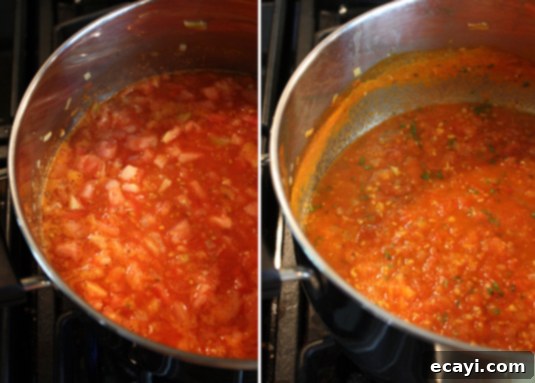
Versatile Uses for Your Homemade Fresh Tomato Sauce
The true beauty of this fresh tomato sauce lies in its vibrant, bright flavor, which makes it incredibly versatile. I prefer not to weigh it down with heavy ground meats, allowing the true taste of the tomatoes and aromatics to shine. This light yet flavorful profile makes it a star in a variety of dishes. Here are just a few delicious ways to enjoy your homemade sauce, showcasing its adaptability:
- Classic Pasta Dishes: The simplest and often most satisfying use. Serve it with linguine, spaghetti, or your favorite pasta shape, a generous sprinkle of fresh basil, and shaved Parmigiano-Reggiano. The purity of the sauce truly shines here, highlighting the quality of your fresh tomatoes.
- Hearty Pasta with Tuna and Olives: For a more robust and quick meal, simmer the fresh sauce with high-quality canned tuna (packed in olive oil, drained) and chopped black olives. Serve this delightful combination over rigatoni pasta, finished with a generous grating of Parmigiano-Reggiano for an umami-rich dish.
- Pizza Base: This fresh tomato sauce makes an incredible, light, and flavorful base for homemade pizzas. Its bright flavor is a perfect counterpoint to creamy mozzarella and other toppings, preventing the pizza from feeling heavy.
- Bruschetta: Transform simple grilled or toasted croutons into elegant bruschetta by topping them with a spoonful of warm fresh tomato sauce, torn fresh mozzarella, and a drizzle of extra virgin olive oil. A sprinkle of fresh basil makes it irresistible.
- Vegetarian Lasagna or Cannelloni: Use it as the foundational sauce in a rich vegetarian lasagna, layering it with ricotta, spinach, and pasta sheets. Alternatively, serve it alongside savory veal and spinach cannelloni for an authentic Italian experience, where the sauce provides a fresh counterpoint to the rich filling.
- Meatball Companion: Incorporate cooked caramelized lemon meatballs into the sauce and gently simmer to meld flavors. Serve with spaghetti or polenta for a comforting and flavorful meal that’s a step above the ordinary.
- As a Dip: Serve your warm fresh tomato sauce with crusty bread, focaccia, or even as a flavorful dip for arancini, fried mozzarella sticks, or vegetable crudités.
- Shakshuka Base: For a delicious breakfast or brunch, use this fresh tomato sauce as the flavorful base for a quick shakshuka, poaching eggs directly in the simmering sauce until set. It provides a bright and tangy foundation for this popular dish.
My favorite fresh tomato sauce, richly flavored with onion, garlic, dried oregano, red pepper flakes, and fresh basil – a culinary masterpiece ready to elevate any meal with its vibrant taste and aroma.
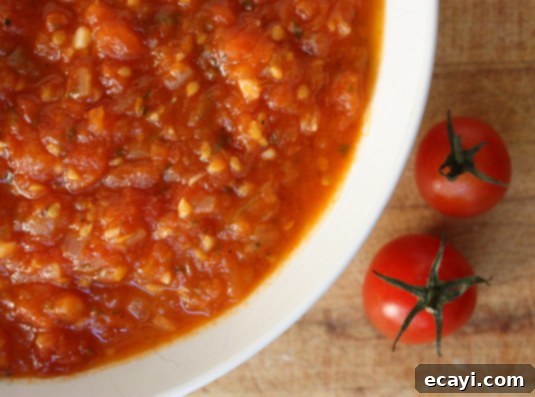
Make Your Own Authentic Fresh Tomato Sauce
Making a truly exceptional fresh tomato sauce is a rewarding experience that connects you to the ingredients and the rich traditions of Italian cooking. This recipe, a refined version drawing inspiration from foundational texts like Deborah Madison’s Vegetarian Cooking for Everyone, is designed to be versatile and deeply flavorful, ready to be incorporated into a multitude of dishes. The addition of white wine to deglaze the pan after the aromatics have cooked not only deepens the flavors but also subtly mellows the natural acidity of the tomatoes, creating a more harmonious and complex sauce. This technique adds an extra layer of gourmet touch to your homemade fresh tomato sauce.
Remember the golden rule for fresh basil: its delicate aroma and flavor are best preserved by adding it right before serving, once the sauce is hot but off the heat. High heat and freezing will diminish its vibrant essence, causing it to lose its distinctive fresh taste and bright green color. If you plan to freeze batches of your sauce for later enjoyment, omit the basil during cooking and stir in fresh leaves after thawing and reheating. This small detail makes a significant difference, ensuring you experience the full, bright flavor of this cherished herb, making your fresh tomato sauce truly pop.
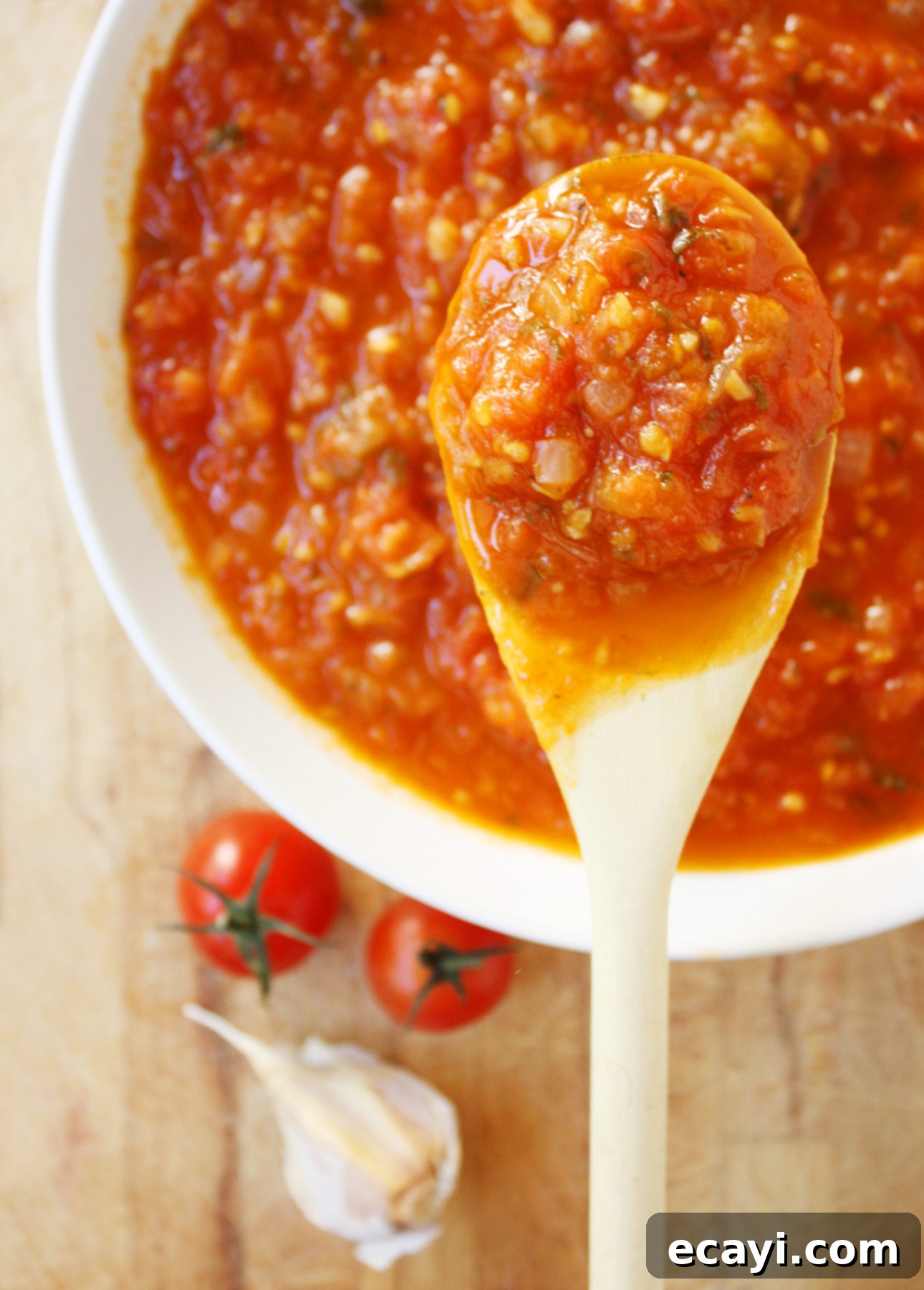
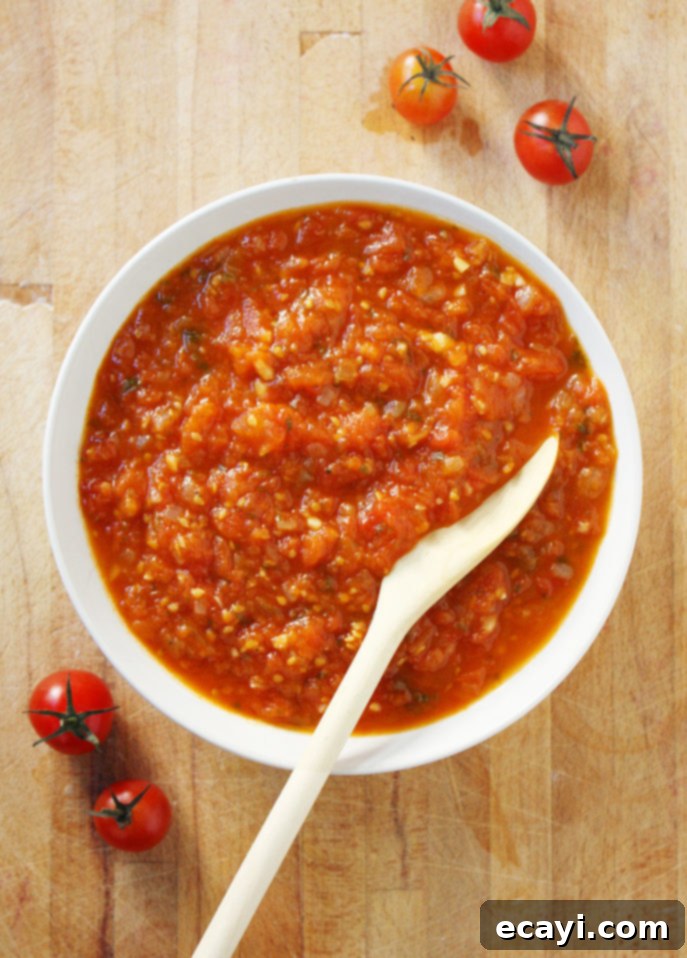
Pin Recipe
Fresh Tomato Sauce Recipe
Ingredients
- 5 lbs fresh tomatoes, such as Roma, San Marzano, or other plum-shaped varieties (or any ripe garden tomatoes)
- 2 tbsp extra-virgin olive oil
- 1 medium yellow onion, finely minced
- 4 cloves garlic, minced
- 1/2 tsp crushed red pepper flakes
- 1/4 cup dry white wine, such as a Pinot Grigio or Sauvignon Blanc (optional, but recommended for depth)
- 1/2 tsp dried oregano
- 1 to 1 1/2 tsp kosher salt, or fine sea salt, adjusted to taste
- Freshly ground black pepper
To serve (add just before serving if not freezing):
- Fresh basil leaves, chopped or torn
Instructions
-
1. Peel the Tomatoes: Bring a large pot of water to a vigorous boil. Score a shallow “X” on the bottom of each tomato. Working in batches (to avoid overcrowding), plunge tomatoes into the boiling water for 10-15 seconds, or until the skin begins to curl back. Immediately transfer them to an ice bath to cool. Once cool enough to handle, easily peel off the skins.
-
2. Prepare the Tomatoes: After peeling, roughly chop the tomatoes. The size of the chop is up to your preference – coarser for a chunkier sauce, finer for a smoother one. Retain all the flesh, seeds, and juices in a bowl, as these contribute significantly to the sauce’s flavor and body.
-
3. Cook the Aromatic Base: In a large, heavy-bottomed pot, heat the olive oil over medium-low heat. Add the minced onion, garlic, and crushed red pepper flakes. Sauté gently for about 5 minutes until the onion is translucent and softened, being careful not to brown the garlic. Pour in the dry white wine and scrape up any flavorful bits from the bottom of the pot. Allow the wine to evaporate completely, about 3 minutes.
-
4. Simmer the Sauce: Add the chopped tomatoes (including their juices), dried oregano, 1/2 teaspoon of salt, and a generous grind of black pepper to the pot. Increase the heat to medium-high and bring the sauce to a gentle boil. Once boiling, reduce the heat to low and let the sauce simmer, uncovered, stirring occasionally.
-
5. Achieve Desired Consistency: The simmering time will vary significantly, from 20 to 45 minutes, depending on the water content of your tomatoes. You want a thick, rich sauce, not a watery one. To check for readiness, observe the surface after about 5 minutes of simmering. Initially, a thick layer of watery juices will rise. As the sauce reduces, this layer will diminish, and the sauce will thicken, with tomato chunks becoming more prominent. It’s ready when it’s topped with just a thin layer of juice and has a spoon-coating consistency.

-
6. Final Seasoning and Basil: Once the sauce has reached your desired consistency, remove it from the heat. Taste and adjust seasoning with an additional 1/2 to 1 teaspoon (2 to 5 ml) of salt and more black pepper if needed. Stir in the fresh basil leaves just before serving to preserve their delicate flavor.
-
7. Storage: If not serving immediately, let the sauce cool completely. Store in airtight containers in the refrigerator for up to 1 week, or freeze for up to 3 months. If freezing, add fresh basil after thawing and reheating for best flavor.
Did you make this Homemade Fresh Tomato Sauce?
I’d love to hear how it turned out! Leave a comment below or share a picture on Instagram and tag it with @foodnouveau so I can see your delicious creation!
This site is a participant in the Amazon Associates Program, an affiliate advertising program designed to provide a means for the site to earn fees by linking to Amazon and affiliated sites.
If you click on an affiliate link, I may earn advertising or referral fees if you make a purchase through such links, at no extra cost to you. This helps me creating new content for the blog–so thank you! Learn more about advertising on this site by reading my Disclosure Policy.
